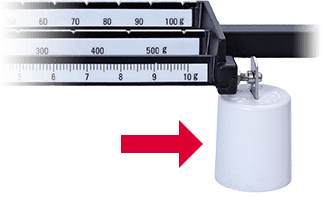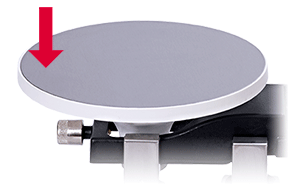Please ensure your browser's zoom is set to 100% for optimal viewing.

Features:
A low cost, maintenance-free balance which provides all the convenience of a top loader, yet retains the ruggedness needed for a wide range of lab work. Tiered beam visibility and zero adjust combine to give high speed performance and reduce error. Magnetic damping speeds up weighing by causing the beam to come to rest quickly without affecting sensitivity or accuracy. Optional attachment weights store conveniently in the base when not in use. Capacity: with attachment weights = 2610g (5 lb. 2 oz.), without attachment weights = 610g (1lb. 2oz.).

Unpacking:
Carefully remove the balance and the separate poise (slide weight) from the protective carton. You will find a slit rubber washer lodged underneath the platform, and one rubber washer located above the pointer. The washers are to be removed from the scale.
ACTION: Click and drag the washers to remove them from the scale.
Packing List
a) balance
b) 100g poise
c) 2-1000g attachment weights*
d) 1-500g attachment weight*
e) instruction manual
Set-up:
After placing the balance on a smooth, flat surface, slide the separate poise up into the slot on the back of the center beam. This slot is located between the 400 and 500 g marks on the bottom of the beam.
ACTION: Click and drag the 100g weight up onto the center beam.
Transporting the Balance:
When moving the balance it is essential that you protect the vital parts of the instrument. This is done by placing one hand under the balance base and holding the pan support with the thumb and forefinger between the pan assembly and base. This action lifts the knife blades from their bearing and thus prevents hard from jarring or stronger bumps.
For major relocations we suggest that you reinstall the rubber washers that were removed when the unit was initially unpacked.

Every time you wish to weigh an item on the Triple Beam Balance, you must first "zero" the balance. This sets the calibration of the balance to zero and will ensure that the proper reading will result.
ACTION: Use the Next arrow to proceed to the next instruction.
Step 1: Remove any objects from the platform.
ACTION: Click and drag the beaker to remove it from the platform.
Step 2: Remove any attachment weights from the end of the beams.
ACTION: Click and drag the weight to remove it from the end of the beam.
Step 3: Set all three weight poises to the zero setting.
ACTION: Click and drag each weight poise to its zero position on the left.
The balance is now ready to zero.
ACTION: Click the Next button to proceed.
The zero adjustment knob can be found on the far left side of the main balancing arm. If it is turned clockwise, the balance index pointer will lower. If turned counter clockwise, the index pointer will rise.
The object is to turn the zero knob until the index pointer points to zero.
In the example shown, the index pointer is below the zero mark, thus the zero adjust knob needs to be turned counter clockwise.
ACTION: Click and drag the zero adjustment knob up to center the balance.
The index is now on zero and the balance is ready to weigh an unknown.
Step 1: Place the unknown in the center of the platform.
ACTION: Click and drag the unknown to the platform.
Notice that the index pointer is above the zero mark indicating that the amount of weight on the platform is greater than the poises.
ACTION: Click Next to continue.
Step 2: Move the 100g poise to the right until the index pointer swings below the zero mark, then back it up one notch.
Step 3: Repeat this process with the 10g poise.
Step 4: Slowly move the 1g poise until the index pointer lines up with the zero mark.
ACTION: Drag the poises into position until the scale balances.
The total weight can now be read from the scales.
The readings of the different scales are:
| 100g scale |
= |
100g |
| 10g scale |
= |
50g |
| 1g scale |
= |
7.63g* |
| Total weight |
= |
157.63g |

With the aid of the Model 183 Clamp and Rod Support*, materials can be massed while suspended in water allowing specific gravity determinations. The specimen is hung using fine wire or thread from the bottom of the platform assembly.

The support rod is inserted into a 1/2 inch recess on the underside of the base while the support is secured to a table with the clamp.
In this exercise the computer will select a random mass and set the three scales to that value after clicking "New Unknown." You then read the scales and enter your value in the text box to the right making sure to estimate the second decimal place. Click the "Check Mass" button and the program will compare your value to the true value.

mass 1 x gravity = mass 2 x gravity
The mechanical balance works on the principle that equal masses will be pulled downwards by gravity with equal force. Thus if two equal masses are suspended by a string around a pulley, they balance each other.
If we suspend the two masses from the opposite ends of a balance beam, we add another dimension, length. This length is measured from the pivot point of the beam to where the masses are suspended. The downward pull (torque) on each side is equal to:
torque = mass x gravity x length
If the torque produced on each side is equal, the weights are balanced. If we shorten the length of one side, we must also increase the mass on that side to keep balanced.
ACTION: Drag the arrow to change the length of the right side.

left side length = 164
right side length = 164
100.00


100.00
left side torque:
100.00 x 9.8 x 164 = 160720
right side torque:
100.00 x 9.8 x 164 = 160720
The triple beam balance is built around this principle of a balance beam with equal torques on each side.
The torque produced by the left side of the beam (all the different masses and their distances from the pivot point) equals the torque of the right side of the beam (all the different masses and their distance from the pivot point). This is no easy task to engineer and manufacture. Components of the balance must be made to exacting specs and have the ability to be slightly altered, as to their mass, to allow fine tuning of the balance. The balance cup (underneath the platform), 100 g poise and 10 g poise must all be calibrated and set during manufacturing to ensure proper mass readings.
The three balance beams allow for adjustable lengths of three different masses. The scale on each beam has been set so that the length of the mass, from the pivot point, will produce a specific torque that will counterbalance a specific mass on the opposite side platform. This allows the user to "read" the mass counterbalanced.

The distance between each notch will counterbalance 10 g on the platform

The distance between each notch will counterbalance 100 g on the platform

This poise will counterbalance any value from 0-10 g in 0.1 g values.
 Even higher mass capacities can be reached if attachment weights are used. They have been calibrated so that their mass and their length from the pivot point will counterbalance 500 or 1000 grams. Unlike the poises, their position is set and thus they counterbalance a set value.
Even higher mass capacities can be reached if attachment weights are used. They have been calibrated so that their mass and their length from the pivot point will counterbalance 500 or 1000 grams. Unlike the poises, their position is set and thus they counterbalance a set value.
 Over time and handling the balance may no longer be at factory set balance or "zero." This zero point can be reestablished by using the "zero adjust" knob. This knob is on a threaded rod which allows you to twist it inwards, shortening its length from the pivot point, or twist it outwards, lengthening it. This very small shift in length will add or subtract torque from the left side of the balance.
Over time and handling the balance may no longer be at factory set balance or "zero." This zero point can be reestablished by using the "zero adjust" knob. This knob is on a threaded rod which allows you to twist it inwards, shortening its length from the pivot point, or twist it outwards, lengthening it. This very small shift in length will add or subtract torque from the left side of the balance.
 The "zero" point is read by the indicator attached to the end of the right side of the balance arm.
The "zero" point is read by the indicator attached to the end of the right side of the balance arm.
 As already pointed out, the distance a mass is from the pivot point has an effect on the amount of torque produced. Then why doesn't it matter where you place an unknown weight on the platform to be weighed? Different positions would be different lengths!
As already pointed out, the distance a mass is from the pivot point has an effect on the amount of torque produced. Then why doesn't it matter where you place an unknown weight on the platform to be weighed? Different positions would be different lengths!
 This potential problem is solved by having a single point of contact, for the platform assembly, with the main balance arm. Thus all masses placed on the platform, no matter where, are directed to a single point with a set length from the pivot point.
This potential problem is solved by having a single point of contact, for the platform assembly, with the main balance arm. Thus all masses placed on the platform, no matter where, are directed to a single point with a set length from the pivot point.
 This platform assembly pivot point, like the main balance arm pivot point, consists of a knife edge and bearing. This provides an almost friction free point of contact that increases the accuracy of the balance.
This platform assembly pivot point, like the main balance arm pivot point, consists of a knife edge and bearing. This provides an almost friction free point of contact that increases the accuracy of the balance.
When the torque on each side of the balance arm are nearly equal, the slightest touch or movement of air will cause the balance arm to oscillate. This hinders the user from determining if the balance is actually balanced to zero. The triple beam balance has a system in place to stop these oscillations through the use of a magnetic damper. The end of the main balance arm has an aluminum vane hanging beneath it. This vane moves between four magnets located in the extended arm of the base. The magnetic fields cause a resistance to movement within the aluminum vane thus slowing down and finally stopping the beam oscillations. This resistance is to movement and not an attractive force thus no added torque is applied or diminished by the dampers and the resultant balance point is not altered.

Set Up and Care
A short tutorial on the initial set-up and care for the balance.
Use Tutorial
A complete step-by-step tutorial on zeroing, uses of the weight poises and proper reading of the balance scales.
Practice Weighing
Test your skills in reading the scales of a triple beam balance.
Balance Theory
How mechanical balances work in general and the theory behind the physics of torque.
